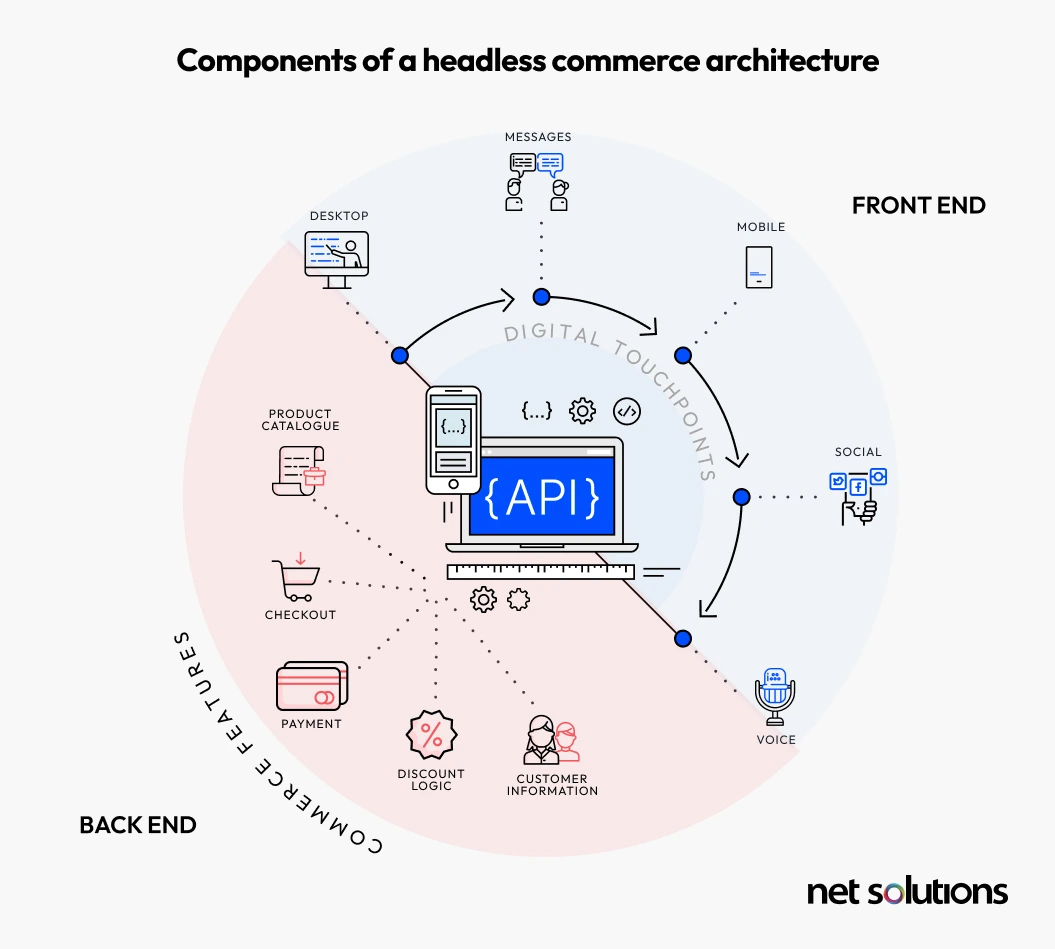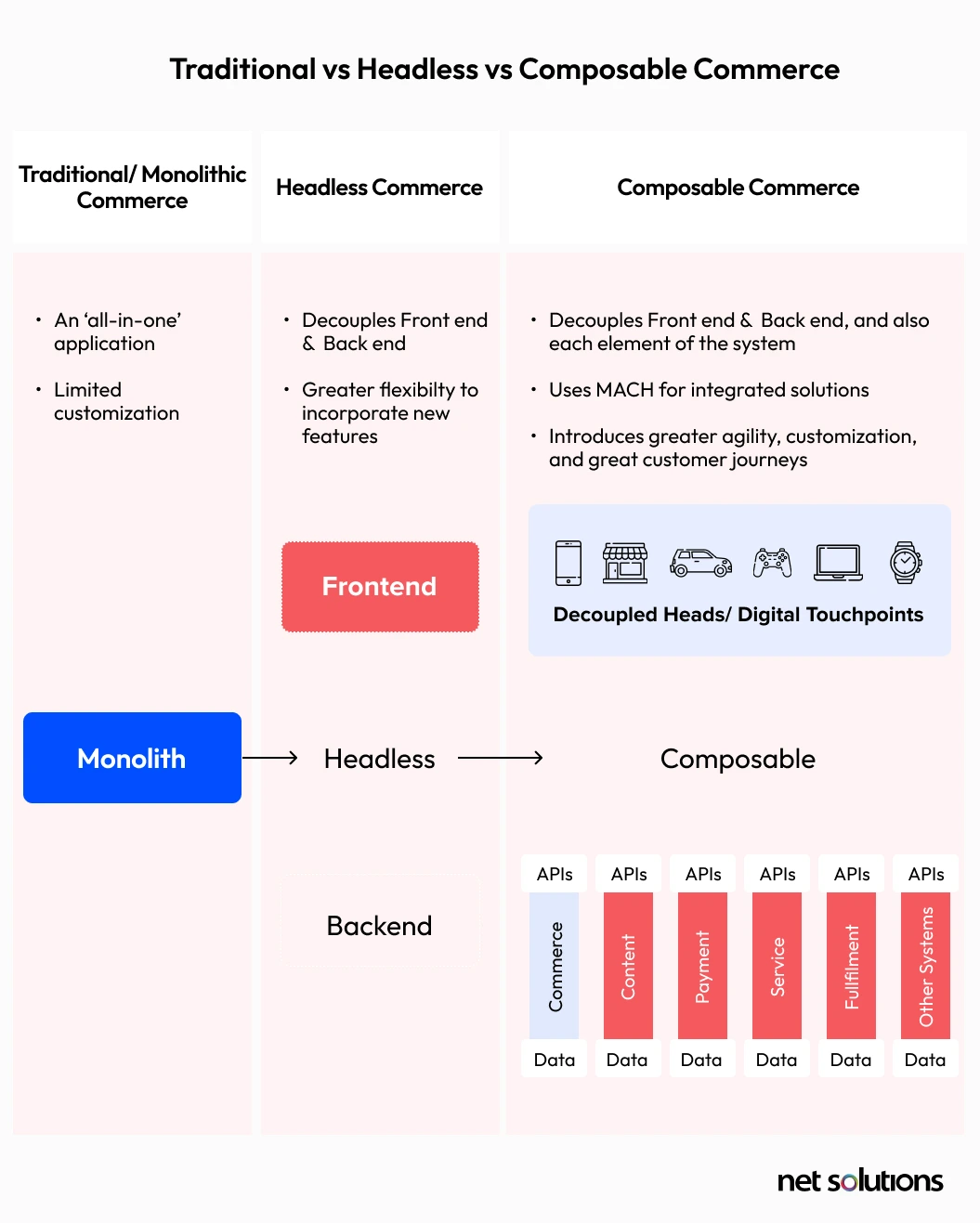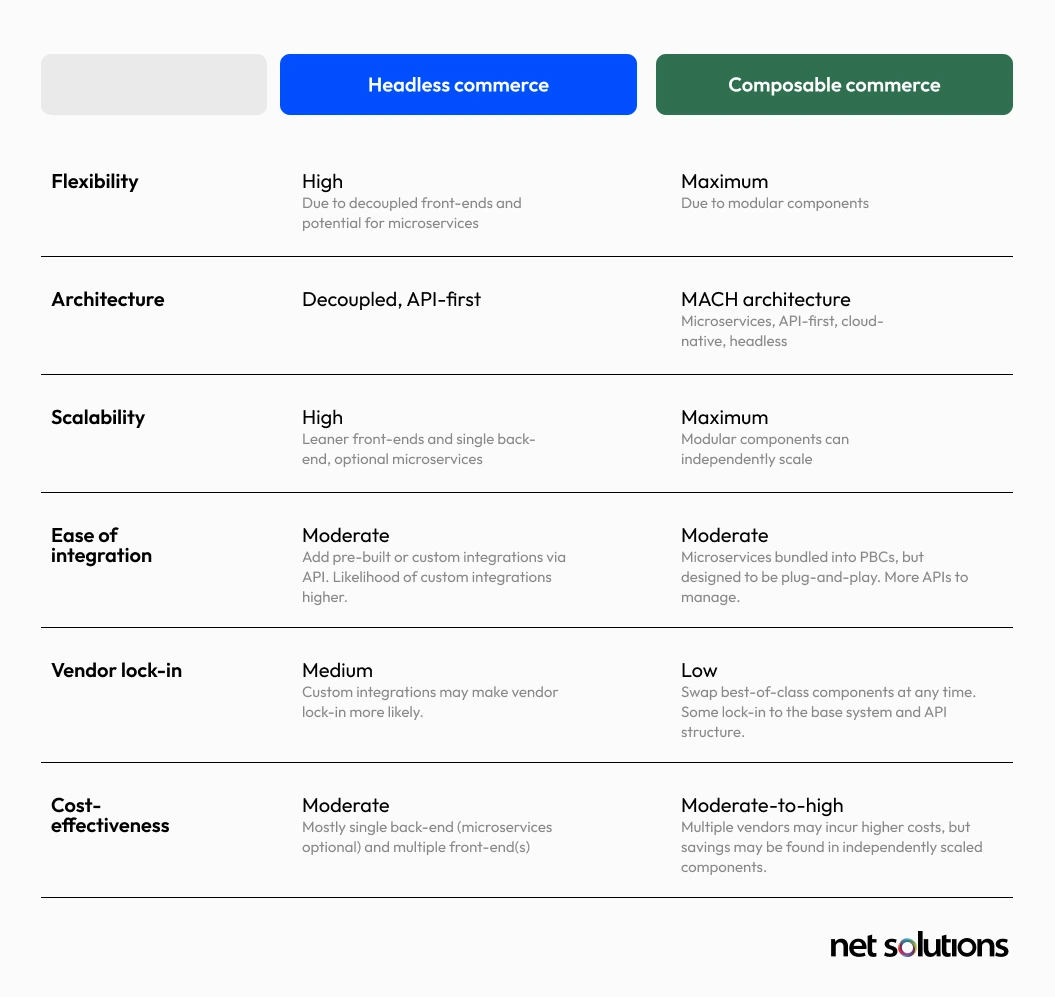eCommerce technology continues to evolve: first from one-size-fits-all traditional platforms, then to a more customizable headless commerce solution, and now to a fully composable commerce. Each evolution brings with it more flexibility and agility, but also more complexity.
As technology and consumer preferences shift rapidly, organizations are grappling with what it takes to manage change in a way that best suits their business needs and capabilities. In this guide, we will talk about:
- The differences between composable commerce vs headless commerce
- The pros and cons of headless and composable commerce
- How to know which commerce architecture is right for your business
After reading this guide, you should be empowered with the information you need to help you choose the right commerce architecture to balance your resources and needs while also future-proofing your commerce capabilities.
What Is Headless Commerce?
Headless commerce is a way of describing the decoupling (separation) of commerce technology, separating the head (the front-end storefronts) from the functional back-end of the store.

In traditional commerce platforms, the back and front-end are tightly coupled: all one system, one code base, one set of features. In this sense, it’s easy to manage a traditional commerce solution, but at the cost of rigidity: you get a one-size-fits-all experience and a one-size-fits-all storefront design for users (e.g. for web, even if it’s a responsive website). Read more on the difference between traditional vs headless commerce.
Common headless commerce platforms include Shopify Plus, BigCommerce, and Adobe Commerce (Magento) for B2C (business-to-consumer). Headless B2B eCommerce platforms include Adobe Commerce (Magento), BigCommerce, Shopware, and Contentful.
In a variant of headless commerce, the back-end is broken into smaller pieces or microservices (various technologies) that can be swapped out independently. This evolution was the beginning of composable commerce.
What Is Composable Commerce?
Composable commerce is an evolution of headless, breaking down the back-end and front-end from one single engine each into independent and interchangeable pieces or components, leading to the term “composable.” As the name suggests, composable commerce is designed for an even greater level of customization.

Unlike the headless commerce variant that relies on microservices, composable commerce uses “packaged business capabilities,” a term that uses “building blocks” designed to meet a business need instead of “services” grouped by developers to build the application. It’s a small difference, but an important one that differentiates how you build the platform (microservices) vs how the platform is used (packaged business capabilities).
Packaged business capabilities (PBCs) may be made up of one or more microservices that are grouped together to better align the commerce platform to business needs, each PBC representing a standalone function.
Many composable commerce platforms continue to market themselves as headless as well, since composable is a continuation of headless ideology. Common composable commerce platforms include BigCommerce, Adobe Commerce (Magento), and commercetools.
What Are the Pros and Cons of Headless Commerce?
Headless commerce is appealing to retailers of all sizes, with 63% planning to shift to headless (according to Market Digits), and 59% of B2B (business to business) businesses already using headless (according to BigCommerce).
Headless commerce advantages
Some of the benefits of headless commerce include:
- Flexibility: the decoupling of the front- and back-ends introduces greater technical agility to adjust your tech stack with different frameworks and languages to create optimized digital experiences for different channels or devices (front-ends).
- Agile: headless commerce platforms are API-first, making it easy to integrate new services or features and to push them to all channels simultaneously.
- Improved performance: lean front-ends and the ability to work on the back-end without impacting front-end performance.
- Improved customer experience: custom front-ends provide more tailored control of the customer experience.
Headless commerce drawbacks
Some of the potential drawbacks of headless commerce include:
- Technical complexity: while traditional platforms can be managed without IT help, headless introduces the need for developers who understand APIs and the tech stacks needed for each front-end.
- Higher cost: managing multiple tech stacks can increase cost, but some of that can be deferred by working with leaner code bases and the time saved customizing the platform, instead using flexible APIs.
- Replatforming complexity: As most organizations already have a commerce solution, headless can introduce cost and risk to move to a new platform.
As this is a comparison post, we’ll next move on to talk about the benefits and drawbacks of composable commerce.
What Are the Pros and Cons of Composable Commerce?
Composable commerce is introducing flexibility into commerce, allowing brands to bring together a completely customized tech stack using best-of-breed solutions (components) to continue to innovate digital experiences at scale. In practice, this granular control, flexibility and complexity appeals to large organizations, those with $100 million to $3.5 billion in annual revenue, of whom 92% have already made the switch to composable commerce, according to Elastic Path 2024 data.
But composable commerce is also within reach of smaller organizations, thanks to innovations in the usability of composable commerce platforms such as BigCommerce and commercetools.
Composable commerce advantages
Composable commerce adopts a similar strategy to headless commerce, but with an ever greater capability to customize components and to scale each component independently. Composable commerce benefits include:
- Personalization: composable commerce is highly driven by consumer expectations, introducing the ability to make smaller, more incremental changes to the tech stack to fine-tune the customer experience.
- Best of breed everything: composable commerce lets you be more granular in your choices for the back-end and front-end components, allowing you to innovate at a faster pace.
- Performance resiliency & speed: composable commerce’s MACH architecture supports the ability for each component to scale independently, which can reap performance improvements. Further, you can swap out individual components without impacting the rest of the infrastructure, introducing resiliency.
- Cost control: As you can choose specific vendors, you only pay for the services you need and each service scales independently, which can help with cost control.
Composable commerce drawbacks
Despite the benefits, switching (replatforming) to composable commerce can be a large undertaking, one that can take 6 months or more, according to recent research and our experience working with clients on replatforming projects. As such, one of the biggest complaints about composable commerce is time. Let’s break down time and other drawbacks:
- Time: the time it takes to implement composable commerce, and the ongoing time commitment to evolving the tech stack.
- Management: An increased number of vendors exponentially increases management time, with the need to keep each component up to date for security and feature evolution.
- IT resources: setting up and managing packaged business components, APIs and front-ends resources significant IT resources and skills, often posing a challenge for organizations facing an IT skills shortage
Let’s have a look at some of the core differences between composable commerce vs headless commerce.
What Are the Differences Between Composable Commerce vs Headless?
At a high level, we can compare headless and composable commerce as follows:

Let’s break down each of these elements and discuss how they differ between composable commerce and headless commerce.
1. Flexibility
A headless platform separates the backend logic from the front-ends, allowing you to choose individual tech stacks for the front-ends and to supplement with microservices, but composable commerce goes one step further and bakes that modularity into its design. This composability provides businesses with the opportunity to meet emerging needs and preferences by changing, expanding or altering PBCs and individual microservices. Since the back-end is designed to make changes easy, integration of new capabilities is very straightforward.
2. Architecture
At its basic nature, headless commerce is decoupled, although many also self-describe as API-first. In contrast, composable commerce is always built with MACH architecture, baking that API-first and microservice (and PBC) capability into how the system is designed and managed.
3. Scalability
While scaling a single back-end is more straightforward, breaking up into individual components allows each component to scale as needed without interrupting the other services. This can have benefits for both performance and cost. With either approach, it is critical to ensure your base commerce platform does not impose API rate limits that could impose ceilings on growth.
4. Ease of integration
APIs are a central part of how both headless and composable commerce platforms work, but composable commerce platforms will make more extensive use of APIs to allow communication between components. Headless commerce integrations, when custom, will require more work. Composable commerce platforms often have extensive marketplaces of “plug and play” integrations you can add in, but increase the management associated with integrations.
5. Vendor lock-in
While there will always be a perceived lock-in when choosing your base platform, whether headless or composable (moving platforms is costly and time consuming), composable commerce does not marry you to specific services, but instead is built to allow you to choose which components you want to add or change.
6. Cost-effectiveness
While headless and composable platforms are both more costly than traditional commerce platforms, and require significantly more front-end development resources, composable commerce does increase development time for maintaining the back-end. However, that increase in cost is offset by the granularity of scaling for each component, which can lead to cost savings and reduces the risk of paying for features you do not need which could be baked-into your headless platform.
How To Choose Between Composable vs Headless Commerce?
The choice between headless and composable is highly dependent on your specific needs, both at a high level based on which architecture approach is right and then more granularly about which specific platform you end up using.
1. Company needs and objectives
Do you sell across many channels, have multiple devices to support your customers, have a highly complex business or sales process? Do you have a competitive marketplace with consumers who have low brand loyalty, prone to switching based on price or experience? Your current business state, your needs, and your short and long-term growth plan all impact your choice in commerce approach.
The more complex or large your organization, and the more competitive your niche, the more likely you should choose composable commerce to help future-proof your commerce capabilities.
2. Performance and scalability
If you are a small, niche site selling very few products or services, your need for performance or scalability are going to be lower than a retailer who manages hundreds or tens of thousands of products, crosses geographic regions, ships worldwide, or has regular massive sales spikes. The more complex your needs for super high performance, the more you should look to composable commerce.
3. Cost and time-to-market
When evaluating approaches and platforms, look not just at the cost of the platform, but the resources required to support that architecture long-term.
If you have lower resource availability (time, budget, IT skills), you’ll want to choose a traditional or headless commerce platform (always preferable over traditional for most growth-minded businesses) to help simplify your site management, while also responding to the need for highly personalized digital experiences across front-ends. However, if you have the time to invest in a long-term strategy for growth, investing in composable commerce will pay dividends in the future in its ability to reduce time-to-market for subsequent changes.
4. Agility and flexibility
If your business relies on continual shifts in approach to stay ‘fresh’ and capture the attention of your B2B or B2C customers, having a composable platform gives you the granularity of control you need to continue to evolve PBCs with new services.
5. Support and maintenance
While on the one hand headless commerce has only a single back-end, making it easier to manage, it may require higher developer costs to do any custom integration work. At the same time, it cannot be ignored that composable commerce requires significant knowledge of APIs and MACH architecture and will require management of more services to maintain service and security. The pros and cons should be weighed in your choice.
6. Technical expertise and development resources
When embarking on any commerce project, it is critical to identify if you have the appropriate resources to undertake the project—to start an eCommerce business, to replatform to a new headless or composable solution, to architect the solution in a way that supports site performance and user experience, and to support those endeavours long term.
For many organizations, a strategic decision to bring on an experienced partner may be appropriate—regardless of organization size or internal resources. In many cases, partners bring a depth of experience that internal teams lack, as well as flexible talent capacity, accelerated development cycles, and specific experience in security or user experience design or site optimization that allows you to build faster, at a lower cost, and a higher resulting outcome.
7. Future digital commerce needs alignment
Every project should consider both short term needs as well as those that may come up in the next three to five years. Technology and consumer preferences will continue to change, and if your business is poised for extreme growth (horizontal to new markets or vertical in capacity), it’s critical to choose a composable platform capable of growing with you.
While all of these factors may influence your opinion on headless commerce vs composable commerce, in some ways the evolution of the industry is removing that choice for you, as many headless commerce solutions are evolving toward composable commerce. In fact, 9 out of 10 of our favorite headless platforms are now composable.
Build Your Solution with Net Solutions
Headless and composable commerce are helping eCommerce businesses stay ahead of changing demands and opportunities in the marketplace, but both approaches require you to invest in continuously managing a tech stack that can, and should, keep changing. The choice in architecture, headless or composable, and the specific choice in platform can be critical to helping support your long-term scalability, flexibility and growth.
If you are ready to create highly tailored customer experiences and support the future of your commerce business, we can help. Net Solutions brings over 24 years of eCommerce development services experience helping B2C and B2B brands build award-winning commerce solutions, from strategy and replatforming to optimization and long-term partnerships designed to keep your commerce stack performing at its best.
Frequently Asked Questions (FAQs)
MACH architecture is an abbreviation for Microservices, API-first, cloud-native, headless, an approach to designing software that is scalable and modular, allowing organizations the ability to remain agile to changing technologies and opportunities. In the context of eCommerce, MACH is the architecture that forms the basis of composable commerce.
Headless and composable commerce both introduce flexibility to deliver innovative digital experiences across channels (front-ends), including mobile, IoT, social media and marketplace, helping to reach omnichannel retailing goals with a simplified backend powering it all.
Composable commerce solutions are more complex but also more flexible, primarily focused on large enterprise and complex business clients who are looking to remain nimble to the latest technologies, while headless commerce can appeal to mid-sized to large organizations who want to be able to deliver personalized experiences across channels, but for whom the latest technologies are not as business-critical.



